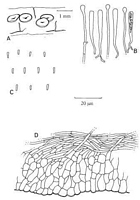|
 Orbilia cunninghamii Orbilia cunninghamii
BiostatusPresent in region - Indigenous. Non endemic
Images (click to enlarge)
Caption: Figure 20. Orbilia cunninghamii, Beaton 43. A. Apothecia. B. Asci and paraphyses. C.
Ascospores. D. Ectal excipulum. |
Article: Sydow, H. (1924). Beiträge zur Kenntnis der Pilzflora Neu-Seelands - I. Annales Mycologici 22(3-6): 293-317 Berlin:.
Notes: Eine Art mit ausserordentlich kleinen Sporen, die wohl der Orbilia botulispora Höhn. nahe steht. Bei letzterer sind jedoch die winzigen Sporen würstchenförmig und fast halbkreisförmig gekrümmt, während sie bei der neuen Art genau stäbchenförmig und gerade sind.
Article: Spooner, B.M. (1987). Helotiales of Australasia: Geoglossaceae, Orbiliaceae, Sclerotiniaceae, Hyaloscyphaceae. Bibliotheca Mycologica 116: 711 p.
Description: APOTHECIA 0.5-1.0 mm diam., gregarious, sessile, superficial on bark. DISC concave,
smooth, translucent, pale amber to orange-yellow, margin somewhat inrolled when dry.
RECEPTACLE discoid, becoming cupulate when dried, smooth, translucent, pale greyish
white. ASCI 32-40 x ca.3 µm, cylindric-clavate, narrowly tapered below with base often
forked, apex truncate or broadly rounded, pore not blued by Melzer's reagent, spore number
uncertain. ASCOSPORES 3.0-4.0(-4.5) x 0.8(-1.0) µm, hyaline, cylindric to clavate-cylindric,
with truncate ends, slightly inequilateral, straight or sometimes slightly curved, nonseptate.
PARAPHYSES stout, hyaline, septate in the lower part, 1.0-1.5 µm diam., apex clavate to
capitate, 2.5-3.0(-3.5) µm diam., overtopping the asci but unencrusted and not forming an
epithecium. MEDULLARY EXCIPULUM composed of interwoven, septate, hyaline, thin-walled hyphae, 1.5-2..O,Mm, diam. ECTAL EXCIPULUM formed of thin-walled but
agglutinated angular cells, usually elongated and arranged in irregular rows at a high angle to
the surface, 7-12 x 4-6 µm, the outermost cells smaller, with slightly thickened walls coated
externally by a thin layer of pale yellowish amorphous matter.
Habitat: On dead bark and wood.
Distribution: Australasia.
Notes: Previously this collection had been misdetermined as 0. epipora (Nyl.) P. Karsten and this
seems to be the basis for the record of that species from Victoria (Beaton & Weste 1979b). In
fact 0. epipora is similar but usually has smaller apothecia, less than 0.5 mm diam., smaller
asci, 22-26 x 2.5 µm, slightly longer narrower ascospores, 3.5-5.0 x 0.6-0.8 µm and
paraphyses apically immersed in a thin encrusting epithecium. Though I have been unable to
trace type material of 0. cunninghamii, described from dead wood, Wellington, New Zealand,
the present collection agrees in all respects with the original description and I therefore refer it
to that species. Though the number of spores per ascus is not clearly seen, it is likely they are
8-spored, as in 0. cunninghamii. The species is evidently very close to 0. gaillardii Saccardo
(1889), also on bark, from Venezuela, which has similar asci and paraphyses but slightly
shorter broader spores, 2.5-3.0 x (0.8-)1.0 µm. 0. acuum Velen.(1934) is also similar but,
according to Svrèek (1954) its asci are smaller, 20-24 x 3.0-3.5 µm and its paraphyses are
apically encrusted.
|